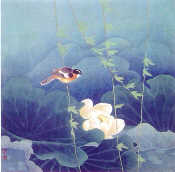
Chinese Brush Painting is an ancient art form that developed in China hundreds of years ago and has recently gained new popularity among artists all over the world.
The style and technique of Chinese painting have varied greatly over the years -- from very detailed portraits to paintings of flowers executed with large brush strokes. Such variations have given rise to a rich and broad tradition with room for personal experimentation and development.
Typical motifs in Chinese Brush Painting include flowers, birds, animals and landscapes. But even more important than the visual image is the message behind the painting: it expresses the inner spirit of the subject or the feelings of the artist. Most Chinese paintings have a calligraphic inscription, such as a saying, beautiful poem, or poetic description of the subject. The painter "signs" the painting by adding a red seal.
Philosophy and symbolism play a huge part in Chinese art. Every animal has its own meaning and can be used to convey an artist's message. Different flowers can symbolize a number of things, such as good fortune, good luck, wisdom, summer, old age, renewal, purity and sweetness.
Chinese Brush Painting presents a particularly interesting challenge due to its unique elements -- the ink, paper and brush. Chinese paintings are done on silk or rice paper, which is very thin and delicate and absorbs paint easily. In ancient times, shells and bones were also used as canvases. Often watercolors or special Chinese paints are used.
The mastery of Chinese Brush Painting requires many years of dedication, serious study and self-discipline. It is one of the world's most demanding art forms.

The single, most astonishing fact about Chinese Brush Painting is that each brush stroke is a defining move that cannot be improved on or corrected. No sketch is prepared and no model is used; the artist paints with rapid, instinctual strokes transporting a mental image to mulberry paper.
From the first to the last stroke, the artist must 'get it right' the first time, unlike in the West where watercolor corrections and painting-over are a part of the technique.
Chinese Brush Painting is more than a representation of an object; it is also a symbolic expression. This is why a full flower is never painted, only a few blossoms representing the subject in its entirety, and all of life (TAO principle.) Rather than looking at a subject as one paints, the artist finds the subject within, and thus becomes a part of nature.










